Through the Glass
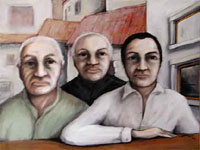
Roundly
An appreciation of the art of Juan Raggo
Maya
Khankhoje
Montreal is an island in the St. Lawrence River but it is not an island unto itself. It started out as a trading post for French explorer and proselytizer Jacques Cartier, but it soon became a busy port, an economic hub and one of the most multiethnic and multilingual cities in Canada, if not the world. In fact, Montreal’s demographic diversity saved Canada from losing Quebec, or lost for Quebec its bid for an independent French-speaking state, depending on how you count votes. Expo 67, the 1976 Olympics and successive waves of immigrants and refugees have further enriched Montreal’s cultural life. Artists crowd its busy sidewalk cafes in summer and desert the streets in winter to do some serious work. One such artist is Chilean-born Juan Raggo, who had to leave his country 27 years ago to build a new life for himself.
For many wanderers, Montreal is initially just a serai, or resting place for the weary traveler, but it soon becomes home. Raggo recognized Montreal as his home when he went back ‘home’ for a visit, only to discover he had become a stranger there. Home is more than a dwelling with four walls. It is peopled with friends and family, sustained by work and embellished by art. For Juan Raggo, home is where he creates his art, where he hangs his paintings and where he receives his friends over a drink around the fireplace.
Physical displacement brings about many types of dislocation. Careers are interrupted, families are torn apart and individuals have to start life from scratch. This is what happened to Juan Raggo. Exile truncated his promising career as an architect (Technical University of Concepción) and as an artist (School of Fine Arts of Viña del Mar) and drove his creativity into temporary hibernation, but not for long.
Today Juan Raggo earns a living as an audiovisuals technician in a UN agency, which frees his personal creativity for the intimate and personal art which both reflects and sustains his own life. The long corridor of his old-fashioned apartment is lined with paintings, sketches and etchings, making it a true rogue’s gallery whose main protagonist is the artist himself: reading a book, writing a poem, peering through a shop window, looking at his mirror image or covering his face in anguish.
Paintings of women also line his walls, presumably women who have passed through his life and then moved on: a woman in a fetal position, another one with her back turned on the world, a third one sitting on a suitcase ready to flee, a fourth one crossing her upturned palms as if to fly away. The most revealing etching depicts a man and a woman sitting on an antique brass bed, each one looking the other way. One could easily title it solitude à deux.
Solitude and displacement are certainly recurrent themes in Raggo’s art. Human figures are often depicted without a sense of location, and location is shown devoid of people. A series of oil paintings depicts Montreal streets with their quaint facades and outdoor spiral staircases, in which footpaths cleared of snow bespeak of human presence not far away. In contrast, empty sun-drenched village streets in Spain suggest the presence of people enjoying a siesta behind shuttered balconies.
Raggo’s sculptures measure yet another dimension of the man: his deep compassion for human beings. Here, an androgynous figure begs to be tapped on the shoulder and told that even the deepest sorrow dissolves with time. There, a woman breaks out of a tree-trunk in a bid for freedom. In a distant corner of the room, crouches a forlorn creature who has lost his hope, but not his dignity.
A word about technique: when looking at Raggo’s cityscapes it is obvious even to the untrained eye that the painter is also a well-schooled architect with a rigorous sense of perspective, which spills into his depiction of the human form. Duo is an engraving of two men drinking in a bar, as seen from above. An Ant’s Eye View is a painting of a long-limbed man as seen from below. A rounded brass bed fills a rounded room. A pen held by a writer looking at the viewer is larger than life.
When the artist is sad, his etchings are dark and gloomy. When the artist is joyful, color and form spill over the boundaries of the frame. When the artist is at peace with himself, he sees the world as rounded as a soap bubble. Catching a glimpse of a large quartz object in the living room, one is not surprised to learn that Juan Raggo likes to gaze at the world through a crystal ball.
All pictures © Juan Raggo
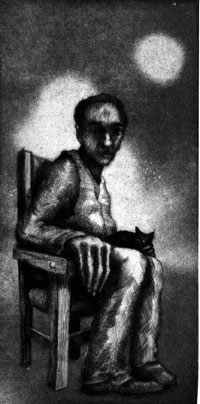 |
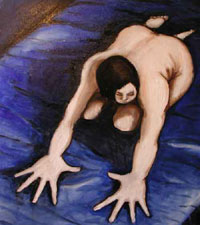 |
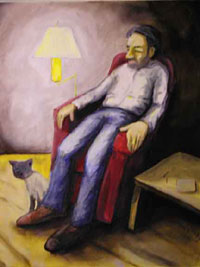 |
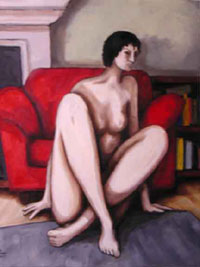 |
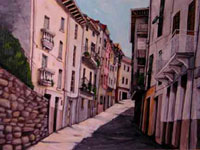 |
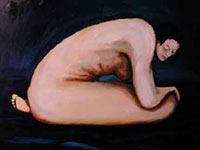 |
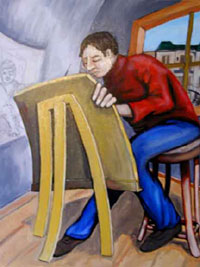 |
 |
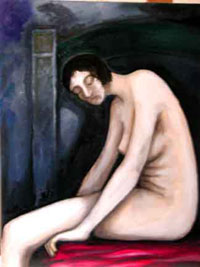 |
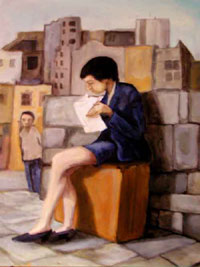 |
THE END